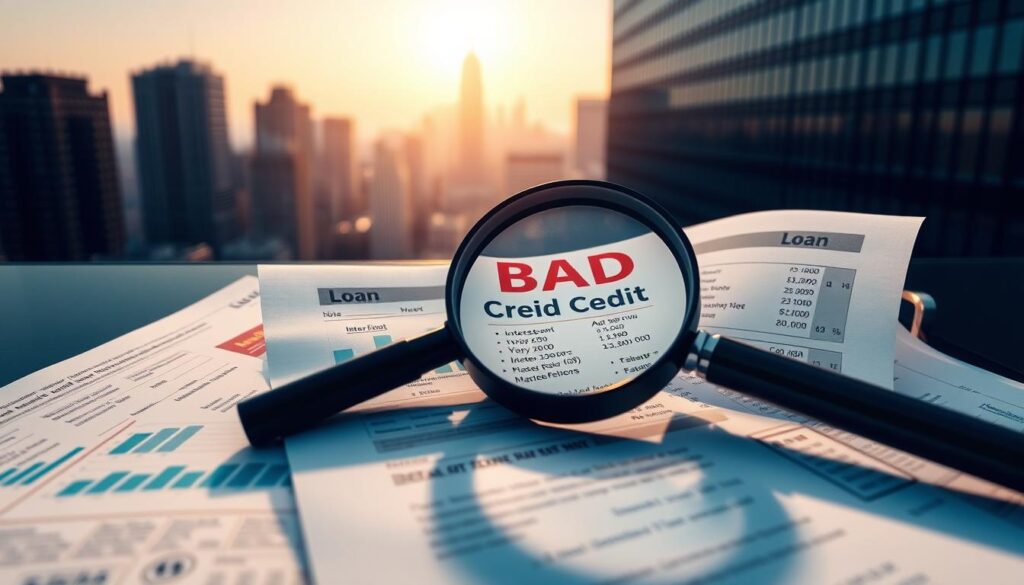Get Loans for Bad Credit – Fast Approval, Low Rates
Did you know nearly 30% of Americans have a credit score below 630? This makes it hard to get a loan from regular lenders. Luckily, there are bad credit loans with fast approval and good rates.
We know how tough it is for people with low credit scores. That’s why we’re here to help you get a loan, even with a bad credit history. With reliable lenders, you can get money fast, usually in 24 hours, without a hard credit check.
In this article, we’ll talk about the good things about bad credit loans. We’ll cover what you need to qualify and how to apply. Our aim is to give you the info you need to make smart choices about your money.
Key Takeaways
- Understand the eligibility criteria for bad credit loans.
- Learn about the benefits of fast approval loans.
- Discover lenders that offer competitive rates.
- Explore the application process for bad credit loans.
- Find out how to access funds quickly, often within 24 hours.
Understanding Bad Credit and Its Impact on Loans
Knowing how bad credit affects loans is key to smart money choices. Bad credit makes it hard to get loans at good rates.
What is Bad Credit?
Bad credit means a low credit score, usually between 300 and 579. It’s based on your past loans, credit card debt, and payment history.
It tells lenders you might be a risk. This could mean higher interest rates or even loan denials.
How Bad Credit Affects Loan Options
Bad credit limits your loan choices and can lead to worse terms. Lenders see you as a higher risk. This can cause:
- Higher interest rates to cover the risk
- Stricter terms, like lower loan amounts
- Need for collateral or a cosigner
So, people with bad credit might look into poor credit loans or bad credit financing. These options are for those with lower scores.
The Importance of Credit Scores
Credit scores are crucial for loan eligibility and rates. A good score means better terms, like lower interest rates.
To keep a good score, you need:
- On-time payments on loans and cards
- Low credit use ratio
- A long credit history
Experts say, “Credit scores show how reliable you are for loans. A good score means better terms.”
“Your credit score is like a financial report card, it tells lenders how likely you are to repay your debts on time.”
Knowing the value of credit scores helps improve your financial standing. This can lead to better loan options later.
| Credit Score Range | Credit Rating | Loan Eligibility |
|---|---|---|
| 300-579 | Poor | Limited Options, Higher Interest Rates |
| 580-669 | Fair | Moderate Options, Competitive Interest Rates |
| 670-739 | Good | Favorable Options, Lower Interest Rates |
| 740+ | Excellent | Best Options, Most Favorable Interest Rates |
Exploring Loan Types Available for Bad Credit
There are many loan options for people with bad credit. You can choose from personal loans to peer-to-peer lending. This variety helps you find the right loan for your financial situation.
Personal Loans
Personal loans are a common choice for bad credit. Companies like Upstart, OneMain Financial, and Prosper offer these loans. They have flexible terms and can be used for many things, like paying off debt or covering emergencies.
When looking at personal loans, check the interest rates and repayment terms. Bad credit personal loans usually have higher rates. It’s important to know the total cost of the loan.
Secured vs. Unsecured Loans
Loans for bad credit can be secured or unsecured. Secured loans need collateral, like a car or property. Unsecured loans don’t need collateral but might have higher rates or stricter terms.
- Secured loans might have lower rates but you could lose the collateral if you miss payments.
- Unsecured loans don’t risk collateral but might have higher rates or fees.
Peer-to-Peer Lending Platforms
Peer-to-peer lending connects borrowers with investors. This can lead to better rates than traditional lenders. Sites like Prosper and Lending Club offer these options for bad credit borrowers.
“Peer-to-peer lending has democratized the lending process, providing opportunities for borrowers who might not qualify through traditional channels.”
These platforms look at more than just credit scores. They might offer better terms for those with bad credit.
How to Qualify for Loans with Bad Credit
Having bad credit doesn’t mean you can’t get a loan. Knowing what lenders look for is crucial. There are common factors that can help you get approved.
Essential Requirements for Loan Approval
To get a loan with bad credit, you need to meet some basic requirements. Lenders like Upstart and OneMain Financial look at your credit score, income, and job history.
Key Requirements Include:
- Minimum credit score: A score above 580 can open more doors.
- Income verification: Lenders want to see you have a steady income.
- Employment history: A stable job can help your loan application.
The Role of Cosigners
A cosigner with good credit can boost your chances. They agree to pay the loan if you can’t.
Benefits of Having a Cosigner:
- Improved approval chances: Good credit from a cosigner can help.
- Better loan terms: You might get lower interest rates or better terms.
Income Verification and Debt-to-Income Ratio
Lenders check your debt-to-income ratio to see if you can handle more debt. They need to verify your income to do this.
Understanding Debt-to-Income Ratio:
| Debt-to-Income Ratio | Lender Perception |
|---|---|
| Below 36% | Favorable; good balance between debt and income. |
| 36% to 43% | Acceptable; may need closer look or stricter terms. |
| Above 43% | High risk; might deny loan or offer less favorable terms. |
By understanding and improving these areas, you can increase your chances of getting a loan, even with bad credit.
The Application Process for Bad Credit Loans
Applying for bad credit loans is easy when you know what to do. It can be tough, but with the right help, you can get a loan that fits your needs.
Step-by-Step Guide to Applying
Getting a bad credit loan involves a few steps. First, research and compare lenders to find the right one for you. Then, fill out the application form with your personal and financial details.
After you apply, the lender will check your credit. They might ask for more documents. Be ready to provide this information quickly to avoid delays.
- Research and compare lenders
- Fill out the application form
- Submit required documentation
- Wait for the lender’s decision
Documents Needed for Application
To apply for a bad credit loan, you’ll need some documents. These include:
- Identification proof (driver’s license, passport)
- Income verification (pay stubs, bank statements)
- Proof of residence (utility bills, lease agreement)
- Bank account information
Having these documents ready can make the application process smoother. It also increases your chances of getting approved.
Tips for a Successful Application
A successful loan application depends on several things. To increase your chances of approval, ensure that your application is complete and accurate. Also, consider having a cosigner or a secured loan to lower the lender’s risk.
“A well-prepared loan application can make all the difference in securing the funds you need, even with bad credit.”
By following these tips and understanding the application process, you can boost your chances of getting a bad credit loan that meets your financial needs.
Finding Lenders Who Offer Bad Credit Loans
Finding a lender for a bad credit loan is the first step. There are many lenders out there. It’s important to know the different types and what they offer.
Traditional Banks vs. Online Lenders
Traditional banks can be tough for people with bad credit. But, online lenders offer flexible loan options for those with poor credit.
Online lenders like Upstart, OneMain Financial, and LendingClub are popular. They have easy applications and quick approvals. This makes them great for those needing money fast.
Local Credit Unions and Their Offerings
Local credit unions are also a good choice for bad credit loans. They are owned by their members and often have better terms. They might look at your whole financial situation, not just your credit score.
Comparing Multiple Lenders
When looking for a bad credit loan, compare different lenders. Look at interest rates, loan terms, and fees. This helps you avoid bad deals.
Make a list of lenders and compare them. This way, you can find the best loan for your needs.
Interest Rates and Fees for Bad Credit Loans
Interest rates and fees are key parts of bad credit loans. They can greatly affect how much you pay back. It’s important to know these costs when you apply for a loan with bad credit.
Understanding Interest Rates
Interest rates on bad credit loans vary a lot. They depend on the lender, the type of loan, and your credit score. Loans for bad credit usually have higher interest rates than those for good credit.
For example, some lenders offer personal loans with APRs from 20% to 36% or more for those with poor credit.
Common Fees Associated with Bad Credit Loans
Bad credit loans also have various fees that increase the total cost. Some common fees include:
- Origination fees: These are charged by lenders for processing the loan. They usually range from 1% to 8% of the loan amount.
- Late payment fees: These are for missing a payment or making a late payment. They can be as high as $25 or more per occurrence.
- Prepayment fees: Some lenders charge a fee for paying off the loan early. This fee is a percentage of the outstanding balance.

How to Negotiate Better Terms
Even though bad credit loans can be expensive, you can negotiate better terms. Here are some tips:
- Shop around: Compare offers from different lenders to find the best rates and terms.
- Improve your credit: A small improvement in your credit score can lead to better loan offers.
- Consider a cosigner: Having a cosigner with good credit can help you qualify for lower interest rates.
- Negotiate directly: Some lenders may be willing to negotiate or offer more favorable terms, if you have a stable income or other positive financial factors.
By understanding the interest rates and fees of bad credit loans and negotiating better terms, you can make more informed decisions. This can help you save money over the life of the loan.
The Benefits of Securing Loans with Bad Credit
For those with bad credit, getting a loan can be a big help. It can meet financial needs and help improve credit scores. Even with bad credit, there are good reasons to get a loan.
Access to Funds for Immediate Needs
Bad credit loans are great for getting money fast. They can help with unexpected bills, car repairs, or other urgent needs. This financial help is crucial.
Building or Rebuilding Credit
These loans can also help improve your credit. Paying on time shows lenders you’re responsible. This can slowly raise your credit score.
Opportunities for Financial Education
Getting and managing a bad credit loan teaches a lot. You learn about smart borrowing, budgeting, and why credit matters. It’s a chance to grow financially.
Let’s look at how bad credit loans compare to other options:
| Loan Type | Interest Rate | Repayment Terms |
|---|---|---|
| Bad Credit Loan | 15%-20% | 1-3 years |
| Traditional Loan | 5%-10% | 3-5 years |
| Payday Loan | 20%-30% | Short-term |
The table shows bad credit loans might have higher rates. But they often have better terms than payday loans.
Risks and Challenges of Bad Credit Loans
Bad credit loans can be a big help for those with poor credit. But, they also come with risks and challenges. It’s important to know these risks to handle the loan process well.
Potential for High Interest Rates
One big risk is high interest rates. Lenders see borrowers with bad credit as risky. So, they charge higher interest rates. High interest rates can make the loan much more expensive, making it hard to pay back.
For example, a 20% interest rate can add thousands to the loan cost. Here’s how interest rates affect repayment:
| Loan Amount | Interest Rate | Total Repayment |
|---|---|---|
| $5,000 | 15% | $6,500 |
| $5,000 | 25% | $8,125 |
| $5,000 | 35% | $10,312 |
Risks of Loan Scams and Predatory Lending
There’s also a risk of loan scams and predatory lending. Predatory lenders might trick borrowers to make more money off them. It’s key to check out lenders well and watch out for offers that seem too good.

Consequences of Missed Payments
Missing payments can lead to big problems. You might face extra fees, higher interest rates, and a worse credit score. It’s crucial to have a solid repayment plan to avoid these issues.
Knowing the risks of missed payments helps borrowers manage their loans better. They can set up automatic payments and talk to lenders if they’re having trouble.
Tips for Managing a Bad Credit Loan Responsibly
Managing a bad credit loan needs careful planning to avoid more financial trouble. It’s important to have a solid plan for repaying the loan.
Developing a Repayment Strategy
To manage your bad credit loan well, create a repayment plan that fits you. Look at your income, expenses, and other debts to figure out how much you can pay each month.
Effective Strategies for Timely Payments
Making timely payments is key to handling bad credit loans. Set up automatic payments to avoid missing any. Also, paying extra when you can shortens the loan term and lowers interest.
Monitoring Credit Reports
After getting a bad credit loan, it’s crucial to watch your credit report. Check it often to make sure it’s right and current. This helps you see how you’re doing in managing your loan and keeping an eye on your credit.
By sticking to these tips and being responsible with your loan, you can improve your financial health and credit score over time.









